Cuba is 5 hours behind GMT – so my brain was not on local time. After oversleeping and gobbling down a huge breakfast in my Havana Casa I re-joined the group to set off S/W in our government approved ‘Tourist’ labelled minibus to Playa Giron, (AKA Bahia de Conchinos – or Bay of Pigs) to learn a little about the Cuban celebration of the humiliation of President Kennedy and the American armed forces that tried in 1961 to invade Cuba and overthrow Castro. A political episode which failed dismally, but which contributed to the US trade embargo which continues to this day. 1189 captured American prisoners were later swapped for medical and food aid worth US$53m, which seems to me a very humanitarian solution.
Playa Giron turned out to be an absolutely delightful bay with a few sunbathers, snorkelers and scuba trainees. I didn’t venture in – having omitted to pack my swimsuit, and it was not suitable for paddling as there was no beach but a steep step off the rocks straight into a foot of water. Apparently it was warm and calm with stripy tropical fish swimming between your feet. A hefty moray eel spooked a couple of the women snorkelers. After a hefty lunch of grilled lobster and the Cuban staple of rice’n’beans we headed for the Bay of Pigs museum.
Temperatures were hovering in the high 20’s with humidity high, so we were happy to doze in our cool bus to Cienfuegos. Outside Havana, this part of Cuba is one of the cleanest and tidiest countries I have ever visited, roads have no potholes, verges and central reservations are manicured with no litter or stray animals. This area is very green and flat dominated by miles of regimented rows of sugar cane – one of the main export crops.
Cienfuegos is another world – build on a grid system by the French in the 19C it is quite beautiful and very well preserved. Wide boulevards with arcade-sheltered walkways and pastel coloured buildings give it a truly elegant look – I really liked it. This is our guide Dayana’s home town she was obviously very proud of it – and her Mum came to say ‘hi’ to her daughter’s protégées. Cienfuegos is where Venezuelan oil is refined, a beautiful marina is a favourite Caribbean over-winter sheltering spot for ocean going yachts and with sugar cane production and the addition of Unesco World Heritage Site money it looks and feels prosperous. Some of the buildings are truly spectacular and we went for a rum-based cocktail serenaded by Cuban musicians on the roof top terrace at one of the government run restaurants overlooking the bay, the incredibly ornate Palacio de Valle. Unfortunately the palace sits cheek by jowl with a brutalist Russian built concrete block hotel. Pockets of Russian high rise blocks of flats mar the outskirts of many towns, contrasting hugely with local architecture. The old (thankfully unused) Russian nuclear site is still to be seen out in the bay – distinctly off limits to anyone other than Naval officials.
After checking in we gathered for a few drinks at a local restaurant, conversation limited by the live music from an energetic pair of troubadours. I stayed in Senora Gredsy’s annex, a comfortable room in a lovely garden setting. Homes in Cienfuegos are mostly individual, single storey, with well watered gardens featuring quite a lot of banana plants. I spotted the street cleaner out very early with his broom and dustbin on wheels, closely followed by the bread seller with a big basket on his bike.
Most Cubans speak Spanish, not English, though our guide is fluent and very knowledgeable. She earns vastly more as a tour guide than using her degree for work, mostly because of the tips from tourists. In this communist country, average Cubans are poor – she tells us that her mother who is a trained accountant, earns less than 30US$ per month, the majority of workers are employed by the state at low but regular wages. Those who own Casas are very well off in comparison even after tax. Cuban families therefore tend to share inherited accommodation with many generations of the family… all contributing to the whole upkeep.
One of our group lives in California and speaks Spanish so she is a big help when negotiating menus etc. Schools, universities and hospitals are provided free by the government, so Cubans are very well educated and obtain any health care they need – one scary fact – for a population of 11m there are more home trained doctors in Cuba than in the whole of Africa. Despite the relative poverty – there is no evidence of the child malnutrition and stunting I see all over Africa, however the history books tells of 3 years of near-starvation in the early 1990’s following the demise of financial support from the Soviet Union.
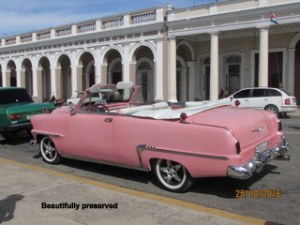
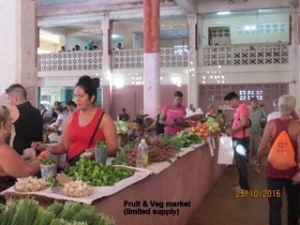
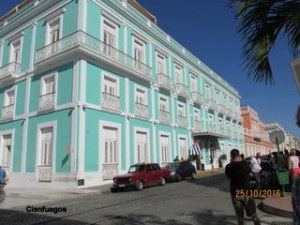
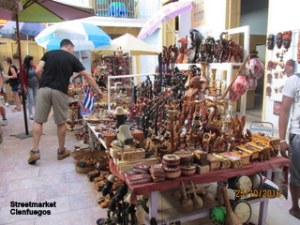
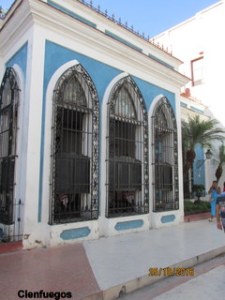
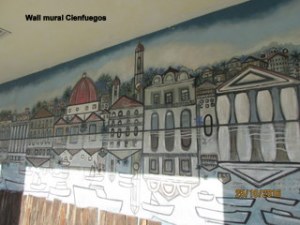
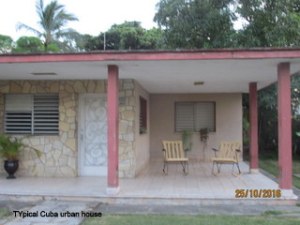
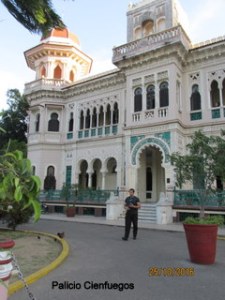
Now that’s what I call a postcard. Love Sandra Ps dashing off to routine eye aoppoitment